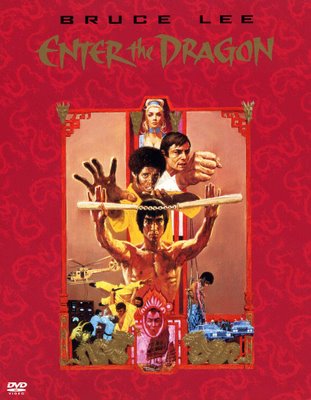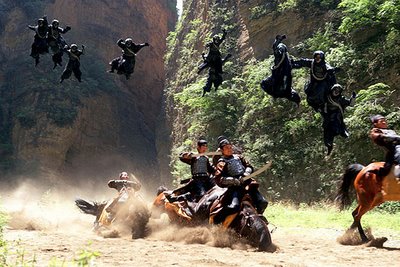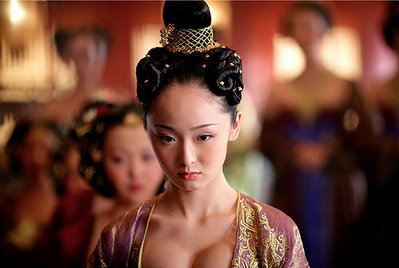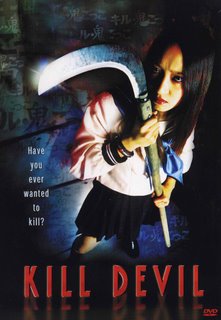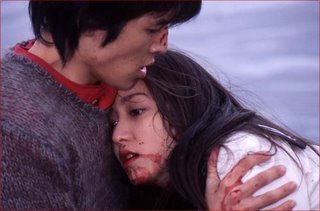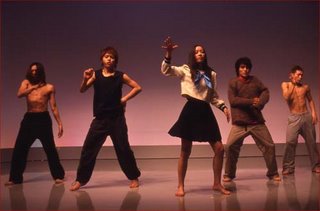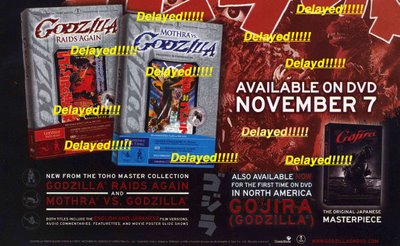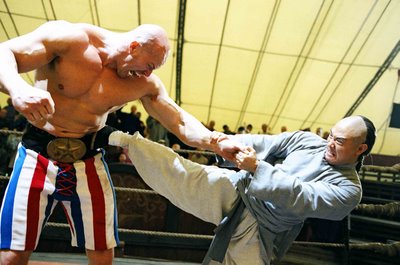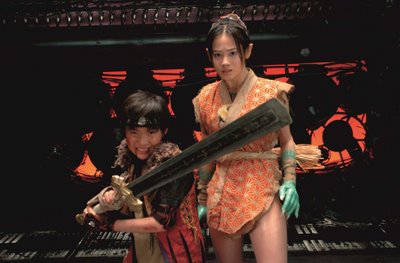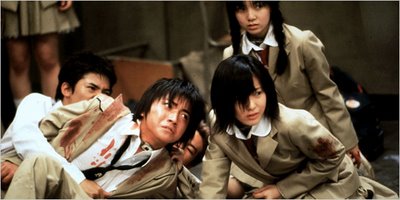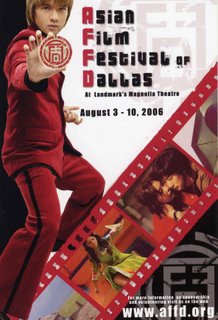
(Photo courtesy Subway Cinema/New York Asian film Festival)
This is a film that delivers, but not the way I expected from the title. There is a mermaid, to be sure, but she's not really a zombie. She just had a near-death experience. Her name is Asami and she starts out as the terrestial wife of Kota Shishio, a professional wrestler. He's played by real life wrestler
Shinya Hashimoto.
As the movie begins, they're having a party at their lovely new home. Among the guests are Kota's teammates from Wrestling Group Zero. All hell breaks loose when uninvited guest Mark Ichijoh, played by karate and K-1 champion
Nicholas Pettas, instigates a fight. See, he's a bit ticked off that Kota killed his brother, even though this seems to have been unintentional.
The house is all but destroyed in the ensuing melee; then an explosion finishes the job. Asami (
Urata Awata), who was upstairs playing piano, is seriously injured in the extreme. While hospitalized, she begins growing scales and making squeaky sounds, a clear indication that she's turning into a mermaid.
Kota hopes that a new house will somehow cure his wife. Abandoned by his teammates, he reluctantly accepts an offer made by Naoto Yamaji (actor
Shiro Sano), a truly sleazy TV producer/director. How sleazy is this guy? Well, his demented actions to increase audience share and improve ratings are justified with a simple, "TV always feeds off the dark side of humans."
And the offer? Kota will get his beautiful new home, but he has to fight his way through a team of killer wrestlers from the United States who are currently inhabiting it. One of these is a drooling mad man who really does come across like a zombie. Another is Eva, a buff amazon played by professional wrestler
April Hunter, who Kota faces in the terrifying "Electric Bath Bout." When he can't bring himself to fight her because she's a woman, his lovely sister-in-law Nami Ishizuka (single-name actress
Sonim)steps in.
The climactic seqence plays out like a videogame. Each succeeding boss is badder than the last. Whether or not you'll know in advance who the final boss is will probably depend on how drawn into the film you are. I was so totally sucked into the action that it didn't occur to me who Kota would face as his last opponent.
Oh! My Zombie Mermaid is delightful popcorn and candy entertainment. I'm not a big fan of professional wrestling, but I really enjoyed this movie. Some of the fight scenes are admittedly pretty gory. But aside from that, if you're in the mood for some mindless, light hearted asian cult cinema, it'll fit the bill just fine.
The imdb entry for
O!MZM is under the Japanese title
A! Ikkenya puroresu. There are several problems with the limited entry. Neither
O!MZM nor the other English names I've come across (
Ah! House Collapses, which I believe is a literal translation of the Japanese title, or
Home Sweet Battlefield) are listed as alternative titles. Also there is no information about the cast, and the entry mistakenly identifies Executive Producer Terry Ito as the director. The film's director is
Naoki Kudo, for whom there is no IMDb entry at this time. Fuller and more reliable information is available at the website of the U.S. distributor,
Eleven Arts, Inc.
[Update #2, 2006.07.31 - I don't know if it's through my efforts in the original posting and my 1st Update, but there have been some improvements at the IMDb site for
O!MZM. The IMDb entry now lists both
Kudo and
Ito as the directors of the film. Also, there is a separate entry for
Kudo; it indicates that
O!MZM was his freshman and thus far only film as writer and as director. If correct, I have to say "Kudos to you, Kudo." The "Full Cast and Crew" screen designates
Ito as "executive" director, a job title new to me. Lastly, the cast members I identified in my original posting above are now listed. Now, if someone can just get IMDb to include the alternate English titles.]
[UPDATE #3 2006.09.14 - I checked the IMDb entry today and am pleased to write that it now includes the info "Also Known As: Oh! My Zombie Mermaid (USA) (informal English title)." ]
Mermaid was one of the 29 films that screened at the recent
New York Asian Film Festival 2006. This was the fifth annual festival put on by
Subway Cinema. I urge you to check out their gorgeous, thoughtful, informative, and just plain great website. In 2003, Roger Corliss of Time magazine chose it as the
Best Movie Website. It's still a stunner. While you're there, consider subscribing to
Subway Cinema News, a "happy guide to Asian entertainment in New York...and beyond!" There's a link to it in the box at the top right of
Subway Cinema's home page, or just click
here.
A final note, and I'm sorry to say it's a sad one. Star
Shinya Hashimoto died on July 11, 2005, a few days after his 40th birthday, from a ruptured brain aneurysm. R.I.P., big guy, and thanks for the good times.



